Patterns - Cambridge Square
by Phyllis Smith
Issue No. 123 - July 1983
"Modern beyond its time" ... words such as these have been used to describe the very modern, very plain, and yet, very lovely Cambridge Square line.
Cambridge Square was first introduced to the trade with a full page advertisement appearing in the December 1951, issue of China, Glass and Decorative Accessories, and Crockery and Glass Journal.
The advertisement glowingly announced that
" ... Cambridge will present at the Pittsburgh China and Glass Show one of the most distinctive new crystal shapes ever created by American glass makers. It is a pattern aloof from the conventional - an ultra-smart, imaginative design brilliant with the beauty of flawless crystal and austere with the mood of the times."
"You are cordially invited to see this exciting new pattern at rooms 101-103 in the William Penn Hotel. On the square ... we believe you'll like it!"
With this description, the new Cambridge Square line was launched into a world that probably was not really ready for anything so completely modern in its design! But, ready or not, this line was put into production and was continued by the Cambridge Glass Company until the company closed its doors for the final time in 1958.
According to the forward in the NCC 1949-53 Catalog Reprint, the catalog pages showing this pattern were added to this catalog in May 1952, with one page being added in October of that year. Approximately seventy pieces were shown on these eight catalog pages and our research tells us that they were produced in crystal only until the introduction of the new color Ebon in late 1953 or very early 1954.
Before we get into the various colors in which this pattern may be found, let us first describe a couple of the features that were considered by some to be quite revolutionary.
First of all, the design of the square base was most unusual for that time period. You should take note of the shape of this base (all sides are the same size). A similar pattern by another company has sometimes been confused for Cambridge Square, but a quick look at the bottom will show the difference - the center is round, not square on this look-alike!
Another feature of this pattern, they seemed to be quite proud of, was their new cup which was available in two sizes - tea (or punch) and coffee! The smaller of the two was the tea cup and it was shown in the August 1952 issue of Crockery and Glass Journal as part of a 15 piece Punch Set meant to retail for $25. The caption under the photo described the cup as "the only seamless cup made that stacks perfectly, open handle also permits hanging." We own several of the larger coffee cups, and the way this handle is made makes it the most comfortable cup to drink from that we have ever encountered. Modern beyond its time ... perhaps, but just right for present day use and collecting! At the end of this article there's a picture showing both sizes of cups and how the cups stack easily.
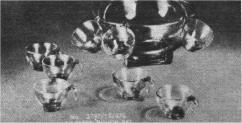 The photo shown at left does not show the punch set exactly as it was
being sold in the 1952 ad, but it does offer you a view of the shape of
the cup. The 1952 set also included a 13½" torte plate and a
chrome ladle.
The photo shown at left does not show the punch set exactly as it was
being sold in the 1952 ad, but it does offer you a view of the shape of
the cup. The 1952 set also included a 13½" torte plate and a
chrome ladle.
In doing the research for this article, I came upon another
interesting (to me at least) advertisement in the July 1952 issue of
Crockery and G1ass Journal. It was a photograph with caption
that read "attractively packaged in a white take-home gift box, this
new addition to the Cambridge Square line will retail at approximately $2.
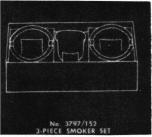 The set (shown at right) includes an urn and two ashtrays."
The set (shown at right) includes an urn and two ashtrays."
The picture of the Smoker Set brings back happy memories of the 10th year reunion of the Cambridge High School Class of 1946. A set exactly like this one was given as a prize to the class member who had "lost the most hair!" Can you guess who that turned out to be? You are absolutely right ... and that set was the first Cambridge glass Bill Smith ever owned. We still display them proudly - unfortunately we weren't smart enough, back then, to keep the box they came in!
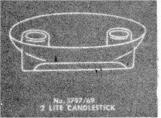 The two-lite candleholder (at left) was featured in a photo in
the February 1954 issue of China, Lamps and Decorative
Accessories. The caption under the photo described it as a
"two-piece candleholder or epergnette." Along with the candleholder
they included a smal1 flower frog that fit between the two candle
pockets ... with the addition of flowers and candles, this little
epergnette made a very petty arrangement The candleholder can be found
in crystal and Ebon.
The two-lite candleholder (at left) was featured in a photo in
the February 1954 issue of China, Lamps and Decorative
Accessories. The caption under the photo described it as a
"two-piece candleholder or epergnette." Along with the candleholder
they included a smal1 flower frog that fit between the two candle
pockets ... with the addition of flowers and candles, this little
epergnette made a very petty arrangement The candleholder can be found
in crystal and Ebon.
Our research material indicates that the new Ebon color came into being in late 1953. In the NCC 1949-53 Catalog Reprints page E-1, Ebon is described as "a black glass with a finish totally unlike any which has been on the market before. To describe this finish is difficult: to say it has a mat finish is incorrect, it really is a rough mat finish to which has been added a luster - a dull sheen which gives it a soft beauty. Borrowing, and changing a little, a phrase from a certain cigarette advertisement, Ebon is both a Treat and a Treatment."
On pages E-2 and E-3 of the reprint you will see the 18 different pieces of Cambridge Square that were produced in Ebon. It is possible you may find others, but these are the only ones we know of at this time.
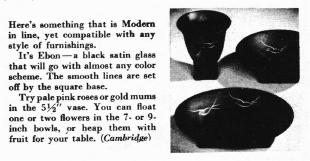 Ebon was decorated quite frequently with birds and stars in gold.
These decorated pieces seem to be more desirable than the plain ones,
and therefore demand a higher price.
Ebon was decorated quite frequently with birds and stars in gold.
These decorated pieces seem to be more desirable than the plain ones,
and therefore demand a higher price.
Since there is no mention of Ebon in the NCC 1956-58 Catalog Reprint or in the 1958 Price List, it is my opinion that Ebon was only in production for a relatively short period of time. It is possible that it was only produced until the plant closed for the first time and was never produced at all during their re-open period.
Now that we have established that Cambridge Square was produced in crystal and Ebon, let's add Carmen to the list. Very few pieces were produced in this pattern in Carmen by the Cambridge Glass Company. In fact we can find reference to only four items and they were:
- a 10" shallow bowl
- 10" round bowl
- 11½" cake plate
- 9½" vase with crystal foot
In the September 1977 (Issue #53) of the CRYSTAL BALL, Gwen Shumpert wrote an article telling us about the pieces she had found of Carmen Cambridge Square with a sticker on each piece that read "Cambridge by Imperial." Yes, Imperial Glass Company produced several pieces of this pattern in their Ruby color. According to Gwen these items were produced in 1969 and in the following pieces:
- 7" candy box and cover
- 11" and 6½" salad bowls
- 13½" plate
- 10" oval bowl
- 6½" ashtray
- cupped candlesticks
They also produced the 7" candy box and cover in crystal.
Platinum line decorations were used on many pieces of the crystal Cambridge Square. The Cambridge company named the pieces with the platinum decoration Triumph.
While reading through some old Cambridge factory inventories, we were able to dig out a few additional interesting facts concerning this Cambridge Square line.
The #3797 flat tumblers (all seven sizes) were made in crystal Crackle. That's right, we said crackle! They showed up in two different inventories (with less items in the second one), but there is no evidence that they were ever a production item. Surely one or several will show up one of these days.
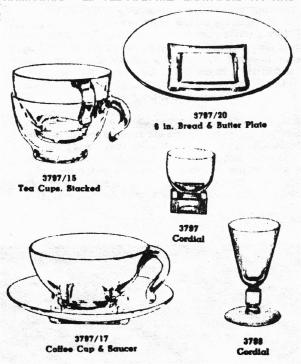 On page 148-D of the NCC 1949-53 Catalog Reprint, the three sizes of
Square candlesticks are shown in Ebony. The inventories indicate that
they also produced the 6½" ashtray in ebony.
On page 148-D of the NCC 1949-53 Catalog Reprint, the three sizes of
Square candlesticks are shown in Ebony. The inventories indicate that
they also produced the 6½" ashtray in ebony.
The 1957 inventory list shows that the #3797/78, 9½" vase was made in Smoke. There were only 15 pieces on hand at that time, so it doesn't seem likely that very many of these vases will ever be found.
To us, the most exciting color information was found on the inventory page that listed the: "#3798 wine and cordial; the #3797/28 plate; and the #3797/57 bowl; all in Crown Tuscan!" Presumedly these pieces were not a part of their regular product line.
It is entirely possible that you may someday find one of the #3797 (flat), or #3798 (stemmed) pieces, with an engraving. The 1957 inventory lists these blanks with "Eng. 9-P." We have been unable to identify this pattern by a name or description.
You may also find one of the three or four shapes that were produced on special order for the Vanadium Corporation of America. These modified (heavier) blanks carry an etched advertisement for Vanadium.
Should you decide to collect the Cambridge Square pattern, it will be possible to amass a complete dinner service in crystal. If you would prefer just a Hostess set, you should be able to do so in both crystal and the Triumph (platinum band decoration) line. The Triumph line did not include cups and saucers, but there were several stemmed items and approximately 12 assorted occasional pieces available.
Colored items were available in occasional type pieces only, and were, perhaps, intended for use with the crystal, or by themselves, as decorative additions to any home.
